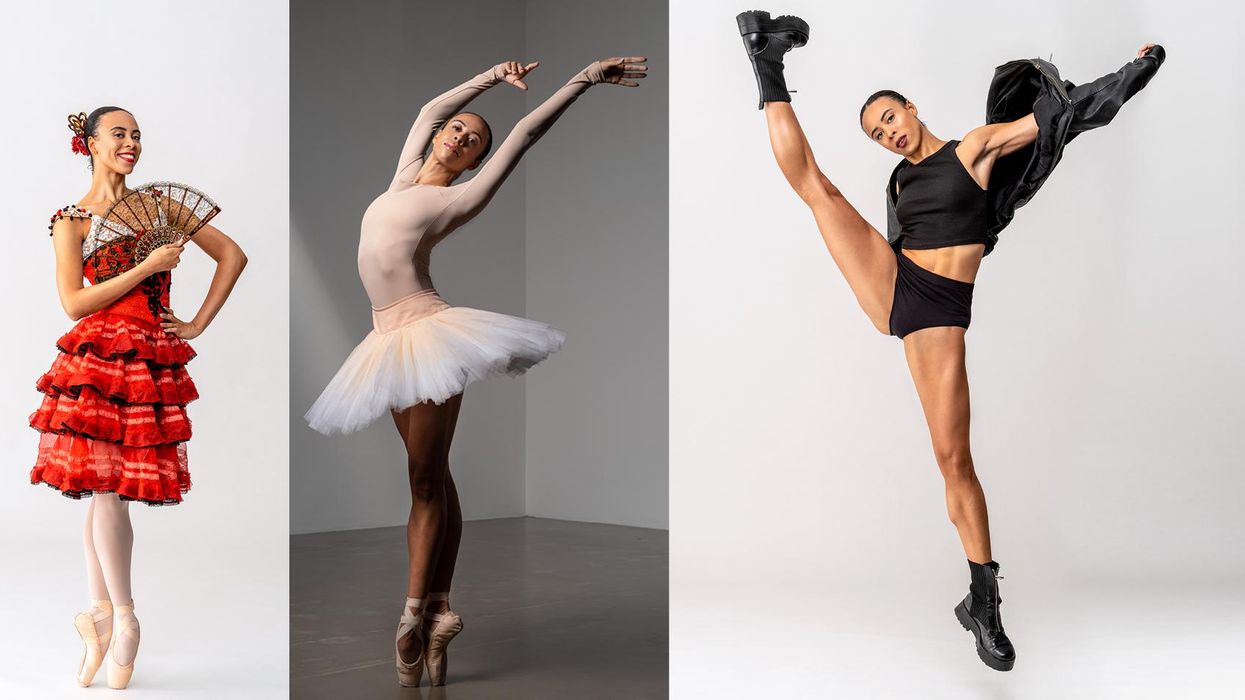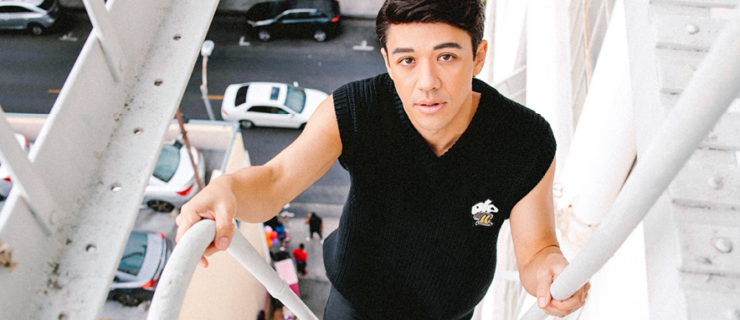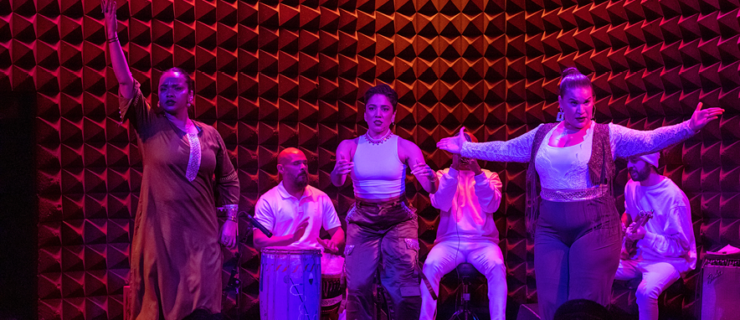Nikisha Fogo Is The New Frontier
Over the past four years Nikisha Fogo, 26, has become one of the hottest underground ballerinas. Until recently, she did not dance with a juggernaut ballet company; she didn’t rack up awards at major international competitions. Instead, she began to earn “street cred” in 2015 as a demi-soloist at Vienna State Ballet, and then grabbed hold of the social media dance community in 2018 as followers watched her build and embody the titular role of Sylvia in artistic director Manuel Legris‘ reconstruction. Her performance prompted him to promote her onstage to first soloist (the company’s equivalent to principal).
Today, her Insta posts are reposted and slid into DMs like old-school mixtapes. Ballet celebs and novices alike are enamored with her technique and versatility, her infectious charm and humility. She has amassed a cultlike following as a next-gen ballerina––not a Black ballerina, but a ballerina, period.

Like the hottest underground artists, when awareness reaches a tipping point, they break through and enter the mainstream. Last November, during the height of COVID-19 lockdowns, San Francisco Ballet quietly added Fogo to its roster of principal dancers.
Audiences got their first taste of Fogo in SFB’s digital season, where she danced both Swan Lake Act II pas de deux and Don Quixote Act III pas de deux (the latter being a dream role she had been slated to perform as a guest with the Royal Swedish Ballet until she was thwarted due to the pandemic). She will make her onstage debut with SFB this December, in The Nutcracker. It will be the first time Americans will have the opportunity to see her live.
The dancing body has been fetishized; hyper-isms of legs, feet, flexibility have become baselines, and “extreme” an aesthetic. What makes Fogo so beguiling is that she is in no way physicallyextreme: Her legs straighten but are not super-hyperextended; her feet are arched, not “cashewed”; she admits to not being extremely flexible or having a lot of turnout. She does have beautiful ballon, is an easy turner and moves quickly as well as she does adagio (although she considers it her weakness). Her clarity, precise pointework and elegant port de bras speak to the chromosomal structure of ballet technique.
In a sea of what feels like futuristic hypermobile bodies, Fogo makes ballet feel…attainable. This is what makes her so refreshing. You are mesmerized not by the instrument but by the music that comes out of it.
It is almost inaccurate to call Fogo a “ballerina.” She considers herself a dancer. Movement is her first language, not ballet, enabling her to physically code-switch. Her father, who is of Jamaican descent, and her Swedish-European mother (Fogo identifies as mixed race/Black) were both hip-hop dancers who opened Sweden’s first hip-hop studio, and her first dance classes were in jazz, hip hop and tap.
Impromptu jam sessions with her sister Shenie (a singer) were a nightly occurrence. “We would just be going for it. Sometimes I would throw some ballet in there,” she says with a laugh. Her parents’ encouragement taught her to trust her instincts, and to laugh at herself. Their belief and support anchored her sense of self, and cultivated confidence.
In pursuit of more training, at 9 she auditioned for the Royal Swedish School of Ballet, where she began to fall in love with the classical form. She went on to London’s Royal Ballet Upper School, and upon graduating in 2013, she joined Vienna State Ballet. Her rise there could be considered meteoric: demi-soloist in 2015, soloist in 2016, first soloist in 2018. In the two years that followed she danced Swanilda, Medora and Odalisque, Tarantella, “Rubies” and William Forsythe’s Artifact Suite.
When Legris announced his departure, Fogo began to plot her own. Helgi Tomasson, artistic director of SFB, recalls meeting Fogo for the first time in London while the company was performing at Sadler’s Wells. “She is a striking dancer,” he says. “The way she moved—I thought she would be ideal for our repertory.” He asked her if she would be interested in the company.
Always looking to grow, the prospect was enticing. “I liked that SFB does classical, neoclassical, contemporary pieces and new choreographers,” she says. “I like to be in the process of creation. That is the way of leaving your mark in the ballet world, a legacy.”

Delayed by the COVID crisis, nothing about her transition was usual: pandemic, closed borders, air travel, the uncertainty of if and when dance, and live performance, would return. “The plan was that my mom or my sister or someone was going to come with me to settle me in,” she says. “But I had to just go alone.” Fogo arrived to a ghost town in November 2020, with no friends and no idea which neighborhood to start looking for an apartment in.
First days at new jobs are usually a flurry of names, faces and navigating new spaces, but COVID protocols meant that the dancers worked in small, isolated pods until August 2021. “I couldn’t really make those connections and get to know people the same way, because you can’t really hang out. We have face masks, also. I don’t even know what they look like.” She had reached a huge milestone in her career and scored a beautiful loft space in San Francisco’s Mission District, and had no one to share it with.
Fogo was unmoored. “You’re used to getting the outside validation, like the energy from the audience and the applause,” she says. “I really miss performing. I realized that I really have to work on finding my self-confidence and being sure of myself from within.”
A fortuitous benefit of pod life was the opportunity to work with Tomasson and fellow newcomer Julian MacKay on a pas de deux for Tomasson’s full-length ballet Harmony. “She was very receptive to anything that I asked her to do. She would execute it so beautifully, and I was inspired by that,” says Tomasson. With performances suspended, rehearsal time and space were abundant. “I felt really privileged to come in and, strangely, do that from the beginning,” says Fogo. “It was nice to really take time on this one thing because that’s what we can do now.” Working with Tomasson had been one of the reasons she chose SFB: “I felt like he could elevate my career, and I could learn from him and his team.”
Fogo was also cast as one of four principal women in choreographer Dwight Rhoden’s new work. “She is indeed a force to be reckoned with,” says Rhoden, who was familiar with her from social media. “From viewing clips online, I knew she was a powerful, technically proficient, risk-taking performer; but when I actually began to work with her, there were layers of richness and a depth that were even more captivating in person.” The yet-to-be-titled ballet is scheduled to premiere in April.
The juxtaposition of Fogo’s work with both Tomasson (classical) and Rhoden (contemporary) speaks to her ability to adroitly shape-shift. “She handled the complexity of my movement with ease, and brought her own perspective to it. Her body carves through the space with authority. She is soulful,” says Rhoden, “and there is an earnest emotionality to her dancing that is not forced, but is very authentic.”

In a twist of irony, shortly after Fogo’s arrival, Tomasson announced he would retire in 2022, after 37 years at the helm. It is bittersweet on both sides—when Tomasson first met her in London, he was not contemplating retiring. “I was looking forward to working with her in different roles through the next few years, but, as things will happen, I came to a point in my life when I said this is my time to step down,” he says.
The prospect of new artistic leadership is always daunting for dancers. For Fogo, it increases her appreciation of this creative process, being able to personally work with Tomasson.
Things will be different for Fogo when the dust from COVID settles and a new director is appointed. She will find herself “center center” on the main stage of ballet. This upcoming season will give American audiences a chance to get to know her better as she stands shoulder to shoulder with SFB’s female powerhouses, the likes of Misa Kuranaga, Frances Chung and Yuan Yuan Tan. “I’m growing into my being a principal dancer—you know, having all these responsibilities—and, yeah, I feel pretty confident,” says Fogo. Even in this truncated COVID context she is making her mark. “I’m already thinking of how I can continue to create for her in future projects,” says Rhoden. “The world needs to see Nikisha Fogo!”




